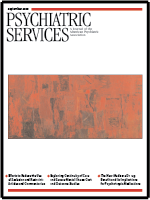Special Section on Seclusion and Restraint: Patients' Reports of Traumatic or Harmful Experiences Within the Psychiatric Setting
Abstract
OBJECTIVE: This study examined the frequency and associated distress of potentially traumatic or harmful experiences occurring within psychiatric settings among persons with severe mental illness who were served by a public-sector mental health system. METHODS: Participants were 142 randomly selected adult psychiatric patients who were recruited through a day hospital program. Participants completed a battery of self-report measures to assess traumatic and harmful events that occurred during the course of their mental health care, lifetime trauma exposure, and symptoms of posttraumatic stress disorder. RESULTS: Data revealed high rates of reported lifetime trauma that occurred within psychiatric settings, including physical assault (31 percent), sexual assault (8 percent), and witnessing traumatic events (63 percent). The reported rates of potentially harmful experiences, such as being around frightening or violent patients (54 percent), were also high. Finally, reported rates of institutional measures of last resort, such as seclusion (59 percent), restraint (34 percent), takedowns (29 percent), and handcuffed transport (65 percent), were also high. Having medications used as a threat or punishment, unwanted sexual advances in a psychiatric setting, inadequate privacy, and sexual assault by a staff member were associated with a history of exposure to sexual assault as an adult. CONCLUSIONS: Findings suggest that traumatic and harmful experiences within psychiatric settings warrant increased attention.



